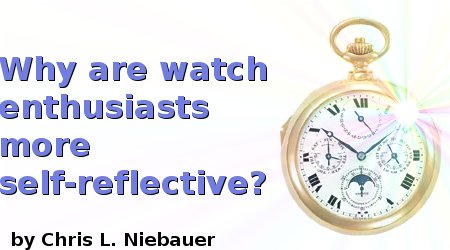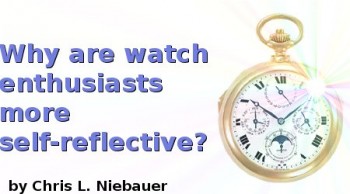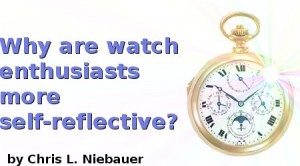Why are watch enthusiasts more self-reflective?
Practically no information exists on the mind of the watch enthusiast. Previous research has found a link between hand preference and Self-reflection, such that those more ambidextrous reported higher levels. It is argued that a mechanical watch and the Self share several common attributes and curiosity to both may have a common origin as complex, […]
Introduction
Although psychologists have investigated an impressive range of individual differences, to my disappointment I was unable to find a single professional study on the personality of the watch enthusiast. This group spends time and money obsessed with a variety of timepieces for some as yet unknown reason. With the faint sounds of my watch collection in the background, I had a rather unusual thought while writing my last research paper. Perhaps the attraction to watches is related to epistemological curiosity, that is, our drive to understand who we are.
The paper I was writing covered several issues about the self and self-reflection. Many psychologists have viewed the mind as a collection of somewhat independent modules, each very different and unique. For example, the part of myself that lectures to a class seems totally alien from the part that plays with my daughter and yet I am still a single person. It may be the left hemisphere specializing in verbal processing that integrates all these parts into a single story of who we are (see Gazzaniga, 1998). There is the suggestion that the right side of the brain monitors, updates and modifies this LH self. (see Ramachandran, 1995). It occurred to me that the right hemisphere monitoring the LH may be similar to reflecting on the self. watch enthusiasts might be more likely to self-reflect In other words, perhaps the right side of the brain is the part of the brain that actually does the reflecting when we think about our Self. Together, this suggests that when we think about who we are and engage in self-reflection, both sides of the brain have to communicate with each other. Although still controversial, there is evidence that one can measure the degree to which the two sides of the brain interact by measuring hand preference. Individuals that use both hands for a number of activities (termed mixed handers) may have a larger connection between the two sides of the brain. I have found that mixed handers report higher levels of self-reflection, presumably because they possess greater connections between the two sides of the brain.
I also found that mixed handers are less likely to engage in rumination. Everyone ruminates to some degree. Think of a time when something happened that you couldn’t accept (like making a fool of yourself) and you kept reliving that moment over and over again. In rumination we fail to update some past event into our current sense of self. It’s like the left side of the brain gets stuck in a loop replaying some event over and over again unable to update and integrate this unpleasant event into who we are. I predicted and found that strong handers (those that have a preference for only one hand and presumably less interaction between the two sides of the brain) would be most likely to ruminate. watch enthusiasts might be more likely to self-reflect Consciousness has a very basic limitation such that we can only be conscious of one thing at a time and this may affect how we self-reflect. When we think about who we are, our total self is too complex to consciously take in at any one moment. Even the simplest person is still more complex than one single thing. However, the brain may have worked out a way to deal with this. Imagine walking into a room and having a vague sense that things just felt right. This experience may be the brain processing several things at once and “presenting” it to your consciousness in a manageable way, a feeling. William James (and recently Mangan, 1993) has referred to this feeling of rightness as being on the fringe of consciousness. I have argued that this is how we know ourselves. We are too complex to take in all at once, so we know who we are by feeling our way around on this fringe. This line of thinking produced the following hypotheses concerning the mind of the watch enthusiast. First, there might be something about the inner workings of a watch that acts as a mirror for our own inner workings. Perhaps this comparison is the origin of the phrase “what makes someone tick?” This suggests that watch enthusiasts might be more likely to self-reflect. In addition, this may be related to being mixed handed. Perhaps watches and the Self are both complex systems; too complex for ordinary consciousness, therefore our understanding of both comes to us in a vague sense or feeling on the fringe of consciousness.
Experiment
My work has been limited to college students and to test my ideas I needed to collect data on the statistically uncommon watch enthusiast. To accomplish this I advertised on a popular watch enthusiast forum and magazine. In total, over two hundred and thirty people participated in an online questionnaire measuring self-reflection, rumination and handedness that took about 20 minutes to complete.
The following results used 255 introductory psychology students as a control group. Perhaps the most interesting finding from this analysis was the comparison between watch enthusiasts and students on measures of self-reflection and rumination. Watch enthusiasts were more self-reflective and less ruminating than students (both t-tests had p values < .001). Of course, even the most novice scientist will quickly object because there are literally dozens of explanations to account for this result. It is very likely that the watch enthusiasts represented a more international group, were older and more educated than the students. However, I believe handedness may offer a solution to deal with these objections. Recent research has shown that hand preference develops very early, perhaps even before birth. And here is one of the most important findings of the study; as a group, the watch enthusiasts displayed more mixed handedness than students (t-test p value < .001). Because handedness differences came first, I am suggesting it was this difference and how it relates to brain organization that resulted in both an interest in the self and an interest in watches. Using handedness in this manner is not new. Because handedness is genetically influenced, psychologists have used its relation to a wide range of phenomena to argue a hereditary origin. Because the RH updates the LH, my other work has found that mixed handers are better at updating their beliefs. However, to say that the watch enthusiast is good at updating beliefs makes little sense if one considers the “Quartz revolution”. Isn’t the quartz watch the most up to date idea of a watch, literally forcing a paradigm shift from their historical mechanical counterparts? While these computer based watches are practical, inexpensive and accurate they must lack something because 92% of watch enthusiasts agreed that their enthusiasm for watches is restricted to mechanical movements and over half reported the highest level of agreement for this question. How could this mixed handed group of watch enthusiasts fail to update their beliefs and accept this new idea of a watch? Is it more important to update our ideas or to be attracted to complexity, that is, the harmonious interactions of several related parts? When asked what does your favorite watch remind you of, the following were strongly correlated with each other, the music of Bach, a high performance sports car and the work of M.C. Escher (all p values < .001). If your favorite watch reminded you of one of these, it very likely reminded you of the other two. mixed handers are better at updating their beliefs All of these systems consist of separate, perceptible parts interacting in a way that gives rise to something greater than the sum of these parts. The feeling that all the parts are interacting in just the right way is exactly what overtook me the first time I held a tourbillon in my hands (one of the world’s most complex mechanical movements). Keep in mind that as a group, nearly everyone restricted their enthusiasm for watches to mechanical watches. This isn’t to say a quartz watch isn’t complex, but the complexity of an integrated circuit simply isn’t perceptible, making it unlikely to result in a feeling of rightness.
Participants that were fascinated by extremely complex mechanical watches (e.g. tourbillons and perpetual calendars) rated each of the following as important to them; the uniqueness of a watch, the number of complications, if the watch is a limited edition and if the watch has an astronomical complication, e.g., showing the phases of the moon (all p values < .05). They were also more likely to have their favorite watch remind them of a high performance sports car and to restrict their enthusiasm for watches to mechanical or automatic movements (both p values < .01). A common theme in the above responses is an interest in uniquely complicated systems, a very good description for who we are, that is the human self. Mixed handers have a preference for complexity and reflect more on what must be the most complex system of all, the self. A mechanical watch is simpler than the mystery of “who we are” but still complicated enough to generate a feeling of rightness because it’s many parts are working together the right way. The results of this study suggest that the potential to be attracted to such complications, be it the self or a mechanical watch may have its origins in brain organization.
Links
- The survey
- The Results (PDF)
References
- Gazzaniga, M.S. (1985). The Social Brain: Discovering the Networks of the Mind. New York: Basic Books.
- Mangan, B. (1993). Taking phenomenology seriously: The “fringe” and its implications for cognitive research. Consciousness and Cognition, 2, 89-108.
- Niebauer, C.L. (2004). Handedness and the fringe of consciousness: Mixed-handers self-reflect while strong-handers ruminate. Consciousness and Cognition 13, (4), 730-745.
- Ramachandran, V.S., & Blakeslee, S. (1998). Phantoms in the Brain. New York: William Morrow and Company.
About the Author
Chris L. Niebauer is a professor of Psychology at Slippery Rock University. He can be reached via email at chris5264 at aol dot com.












I would only point out (being a budding watch enthusiast myself) that many come to love watches later in life….when they can afford to actually collect them. When I was in college I couldn’t afford more than a timex, so I never delved to deeply into the wonderful world of watches.
Your results may be related to the age group of most enthusiasts. The control group used was described as “Introductory Psych. Students.” I imagine these folks are in their early twenties. What was the avg and median age of the watch-lover group?
– Keep on tickin’
-SWOBONO
An age old skeptic’s question:
So what?